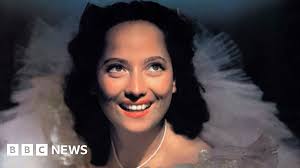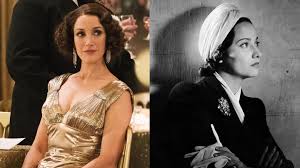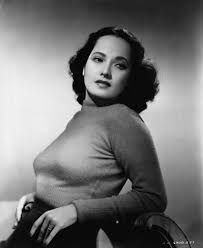Introduction: Merle Oberon
Merle Oberon (February 19, 1911 – November 23, 1979) was a renowned British-American film actress best remembered for her role as the passionate and tormented Cathy in Wuthering Heights (1939), opposite Laurence Olivier’s Heathcliff. Born in Bombay (now Mumbai), India, Oberon’s heritage was a complex blend, with an Indian mother and a British army officer father, Arthur Thompson. Despite her Indian roots, she crafted a fabricated backstory early in her career, claiming Tasmanian origins with Irish, French, and Dutch ancestry, and adopted the name Estelle Merle O’Brien Thompson.
Her journey to fame began in England, where she worked in minor stage and film roles before being discovered by producer Alexander Korda, who not only mentored her but later became her husband. Oberon quickly became a star in both England and Hollywood, known for her dark, expressive eyes and graceful presence. Her notable early roles include Anne Boleyn in The Private Life of Henry VIII (1933) alongside Charles Laughton, Marguerite in The Scarlet Pimpernel (1934) opposite Leslie Howard, and performances with Maurice Chevalier in Folies Bergère (1935).
Throughout her career, she portrayed iconic historical figures, including George Sand in A Song to Remember (1945) and Empress Josephine in Désirée (1954). Her final screen roles were in Hotel (1967) and Interval (1973), marking the end of a distinguished career that spanned over three decades and left a lasting impact on classic cinema.

Overview of Hollywood: Merle Oberon
Hollywood, a district within Los Angeles, California, has become a global symbol of the American film industry. Located northwest of downtown Los Angeles, it’s bordered by Hyperion Avenue and Riverside Drive (east), Beverly Boulevard (south), the Santa Monica Mountains (north), and Beverly Hills (west). Since the early 1900s, Hollywood’s image as the heart of cinematic dreams has been known worldwide, thanks to its favorable climate, diverse landscapes, and ample workforce.
Early History and Development: Merle Oberon
Hollywood’s origins date back to 1853, starting with an adobe house near Los Angeles, then a small city. In 1887, Harvey Wilcox, a prohibitionist from Kansas, laid out Hollywood as a real-estate development aimed at a religious and moral community. Real estate mogul H.J. Whitley, known as the “Father of Hollywood,” later transformed it into a prosperous residential area, adding telephone, electric, and gas services by the turn of the century. Hollywood residents voted to merge with Los Angeles in 1910 due to a lack of sufficient water resources.
Hollywood’s Rise in the Film Industry
The motion picture industry in Hollywood began in earnest in 1908, with The Count of Monte Cristo marking one of the area’s first storytelling films. In 1911, the first film studio opened on Sunset Boulevard, and soon, about 20 companies were producing films locally. Hollywood became the epicenter of American filmmaking by 1915 as numerous filmmakers relocated from the East Coast. Figures such as Cecil B. DeMille, Samuel Goldwyn, and D.W. Griffith became major players, and studios like Paramount, Warner Brothers, and MGM took root.

The Golden Age of Hollywood
Hollywood’s golden age spanned from the silent film era through the arrival of “talkies.” Industry titans like Adolph Zukor, William Fox, and Darryl F. Zanuck led the great studios, creating stars and cinematic masterpieces. This period also fascinated writers, including F. Scott Fitzgerald and Aldous Huxley, who captured the allure and complexity of Hollywood in their work.
Hollywood’s Shift to Television and Decline of Studio Lots
After World War II, as filmmaking shifted toward location shooting, many studios left Hollywood or repurposed their lots for television production. By the 1960s, Hollywood had become the heart of American network television entertainment, marking a significant shift in its role in the entertainment industry.
Iconic Landmarks and Attractions
Hollywood is home to numerous famous landmarks:
- Hollywood Bowl: A natural amphitheater, since 1922 it has hosted outdoor concerts under the stars.
- The Greek Theatre: Located in Griffith Park, this is another renowned concert venue.
- Grauman’s Chinese Theatre: Known for its concrete forecourt featuring the handprints and footprints of famous celebrities.
- Hollywood Walk of Fame: A tribute along Hollywood Boulevard to stars of the entertainment industry.
- Hollywood Sign: Originally built in 1923 to advertise real estate, the sign read “Hollywoodland” until the “land” portion was removed in the 1940s.

Neighboring Communities and Notable Resting Places
Hollywood’s neighboring communities of Beverly Hills and Bel Air house numerous stars. The Hollywood Forever Cemetery is the final resting place for celebrities like Rudolph Valentino and Douglas Fairbanks, preserving Hollywood’s legacy.
Revitalization and Modern Hollywood
While Hollywood Boulevard experienced a period of decline with the fall of the old studio system, it saw a renaissance beginning in the late 20th century. The restoration of the Egyptian Theatre in the 1990s by the American Cinematheque is one example of efforts to preserve Hollywood’s historic charm. Today, Hollywood remains a unique blend of historical significance and modern entertainment culture, continuing to inspire filmmakers and tourists alike.
Early Years of Motion Pictures: 1830–1910
Origins of Motion Pictures: Merle Oberon
The foundations of film lie in two optical phenomena: persistence of vision and the phi phenomenon. Persistence of vision allows the brain to retain images for a split second after they disappear, while the phi phenomenon creates a sense of movement between successive images when they follow each other rapidly. Together, these effects enable a series of still images to appear as a continuous motion when projected at specific frame rates—typically 16 frames per second for silent films and 24 frames per second for sound films. Before the invention of photography, early optical toys like the phenakistoscope (1832) and the zoetrope (1834) used phase drawings on spinning disks to mimic movement, laying the groundwork for the moving images we recognize today.
The Photographic Breakthroughs of Daguerre and Talbot: Merle Oberon
In 1839, significant advancements in photography began shaping the path toward film. French painter Louis-Jacques-Mandé Daguerre developed the positive photographic process known as the daguerreotype, while English scientist William Henry Fox Talbot introduced a negative photographic process allowing for multiple positive prints. These developments made it possible to replace drawn images in optical toys with phase photographs, adding realism to the moving images and paving the way for cinematic technology.
Eadweard Muybridge and Motion Photography: Merle Oberon
One of the earliest pioneers of motion photography was Eadweard Muybridge. From 1872 to 1877, Muybridge worked for California Governor Leland Stanford, who wanted to determine if a galloping horse ever lifted all four hooves off the ground simultaneously. Muybridge developed a method using multiple cameras set up along a racetrack, each triggered by the horse’s hooves to capture successive images. In 1877, he created the first “moving picture” by projecting these sequential photos on a rotating disk, demonstrating the horse’s movement as it had occurred in real life.

Étienne-Jules Marey and the Chronophotographic Gun: Merle Oberon
French physiologist Étienne-Jules Marey advanced Muybridge’s work by inventing the chronophotographic gun in 1882. This camera, designed like a rifle, could capture 12 photos per second, making it ideal for studying rapid movements, such as birds in flight. Although Marey’s purpose was scientific analysis rather than cinematic storytelling, his work in high-speed photography laid crucial groundwork for future motion picture technology.
The Introduction of Celluloid Film by Hannibal Goodwin and George Eastman
In 1887, Hannibal Goodwin, an Episcopalian minister from Newark, New Jersey, conceptualized using celluloid as a film base. George Eastman soon after started producing celluloid roll film in 1889, which proved essential for cinematography. Unlike glass plates or paper strips, celluloid could handle the thousands of images required to capture longer, more dynamic events, making it the preferred medium for motion pictures.
Louis Le Prince and the First Motion Picture Camera: Merle Oberon
French-born inventor Louis Le Prince took the next step by combining celluloid film with the techniques pioneered by Muybridge and Marey. In 1888, he filmed several short movies in Leeds, England, and was preparing to showcase his work in New York in 1890. However, Le Prince mysteriously disappeared during a trip to France, and his contributions to film went unrecognized for many years.
William Kennedy Laurie Dickson and Edison’s Motion-Picture Camera
It was William Kennedy Laurie Dickson, working in Thomas Edison’s New Jersey lab, who eventually created what became widely regarded as the first motion-picture camera. This development solidified the United States’ role in the early history of film, setting the stage for Hollywood to emerge as the world’s cinematic capital.
The Invention of the Kinetograph and Kinetoscope
In 1889, Thomas Edison and his assistant W.K.L. Dickson developed the Kinetograph, one of the earliest motion-picture cameras. Inspired by inventors like Eadweard Muybridge and Étienne-Jules Marey, Dickson engineered a device that used an intermittent mechanism and a perforated celluloid film strip, enabling the recording of images at around 40 frames per second.
The Kinetoscope: A New Way to View Motion Pictures
While the Kinetograph could record moving images, Edison initially intended his motion pictures as a visual complement to his phonograph. This idea led to the invention of the Kinetoscope in 1891. The Kinetoscope was a single-viewer device with an eyepiece, where people could watch short films looped through a series of rollers.
The Lumière Brothers and the Cinématographe: Merle Oberon
In Europe, inspired by Edison’s devices, Auguste and Louis Lumière developed the Cinématographe in 1895. Unlike Edison’s heavy, battery-driven Kinetograph, the Cinématographe was lightweight, hand-cranked, and portable, allowing filmmakers to shoot on location. This camera could record, develop, and project films at 16 frames per second, creating a more accessible viewing experience and paving the way for cinema’s growth in Europe.
Early Film Projection in the United States: The Vitascope
With the rise of projection technology, Edison introduced the Vitascope in 1896, expanding film screenings to public venues. The Vitascope marked the beginning of commercial film exhibition in the United States, initially presented in vaudeville theaters. It helped popularize motion pictures as public spectacles, attracting wide audiences to see “animated photographs.”
Innovations in Britain and the Development of Narrative Film
In Britain, inventors like Robert W. Paul, George Albert Smith, and James Williamson experimented with new cinematic techniques. They introduced trick films, superimpositions, and close-up shots and began exploring editing techniques. Notably, Cecil Hepworth produced Rescued by Rover in 1905, a landmark in narrative editing that influenced later developments in storytelling through film.
The “Novelty Period” and the Spread of Cinema
During the 1890s, motion pictures were primarily seen as curiosities or novelties, with films viewed through devices like the Kinetoscope or as part of vaudeville acts. However, as projection equipment became widely available, films began to be presented as standalone attractions. This transition laid the groundwork for the modern film industry, with the emphasis shifting toward permanent theaters and narrative storytelling.
Conclusion: The Foundations of Modern Cinema
The collaborative efforts of inventors across continents set the stage for cinema’s evolution. Edison’s Kinetograph and Kinetoscope, the Lumière brothers’ Cinématographe, and innovations by British filmmakers created the fundamental mechanics and techniques that define cinema today. By the early 20th century, the film industry was poised for its next leap into narrative and visual storytelling.





